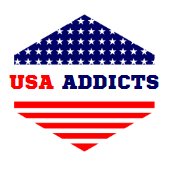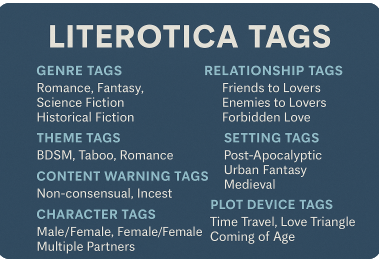Introduction to Literotica Tags
On platforms like Literotica, where stories vary across a wide spectrum of themes, genres, and content types, tags play a crucial role in organizing and categorizing these narratives. Literotica tags are keywords or phrases that authors assign to their stories to help readers quickly understand what a story contains.
Think of them as signposts that guide readers toward the kind of content they want to explore, while also allowing writers to present their work to the right audience.
For both readers and writers, these tags are essential tools. Readers use them to filter through thousands of stories and find something that matches their preferences.
Writers, on the other hand, rely on accurate tags to ensure that their stories are discovered by those who would appreciate them most. Without effective tagging, even the best stories can remain buried under less relevant content.
The Role of Tags in Story Discovery
Tags are the backbone of story discovery on Literotica. Since the site hosts an immense variety of stories, users need a way to sift through the content efficiently. Literotica tags serve this purpose in three main ways:
- Search Enhancement: By typing in a keyword, users can find stories that match their interests based on tags used by authors.
- Content Clarity: Tags offer a quick overview of the story’s themes, plot, and characters, helping readers decide if the story suits their tastes.
- Reader Satisfaction: When a story’s tags match its content, it builds trust with readers. They know what to expect and are more likely to leave positive feedback or come back for more.
Whether you’re into slow-burn romance, dark taboo tales, or futuristic science fiction, Literotica tags can lead you straight to the perfect read.
Types of Literotica Tags
Literotica provides a flexible tagging system that allows for detailed categorization. Below is an in-depth look at the different types of Literotica tags commonly used:
1. Genre Tags
Genre tags define the overall category of the story. These tags tell readers what kind of narrative framework to expect. Some popular genre tags include:
| Genre Tag | Description |
|---|---|
| Romance | Focused on romantic relationships |
| Sci-Fi | Science fiction-based settings or plots |
| Fantasy | Involving magical elements or worlds |
| Horror | Designed to frighten or disturb |
| Historical | Set in a specific historical period |
2. Theme and Mood Tags
Theme tags describe the story’s emotional tone or overarching subject. They help readers prepare for the kind of feelings or experiences the story may evoke.
Examples include:
- Dark
- Light-hearted
- Suspenseful
- Erotic
- Emotional
3. Character and Relationship Tags
These tags indicate who the characters are and what kind of dynamics they share. This can range from their gender to their emotional or power-based connections.
Common examples:
- Enemies to Lovers
- Age Gap
- Friends with Benefits
- LGBTQ+
- Forbidden Love
4. Setting and World-Building Tags
Setting tags describe the environment in which the story takes place, which is particularly useful for fantasy, sci-fi, and historical genres.
Examples include:
- Urban Fantasy
- Post-Apocalyptic
- Victorian Era
- Medieval Times
- High School
5. Plot Devices and Tropes
These tags reveal particular storytelling techniques or clichés used in the narrative. For example:
- Love Triangle
- Time Travel
- Amnesia
- Coming of Age
- Secret Identity
6. Content Warning Tags
To promote reader safety and informed consent, some stories carry tags that signal potentially distressing or adult material. Examples include:
- Non-consensual
- Incest
- BDSM
- Violence
- Underage (often restricted)
These tags are critical as they help readers avoid content that may be emotionally triggering or legally sensitive.
7. Kinks and Fetishes
These are explicit tags for readers with specific interests. Since Literotica caters to a wide adult audience, kink-based tags are both popular and necessary.
Examples include:
- Voyeurism
- Foot Fetish
- Roleplay
- Exhibitionism
- Submission/Dominance
8. Sexual Orientation Tags
Sexual identity and orientation tags are important in defining the nature of intimacy in the story:
- Straight (M/F)
- Lesbian (F/F)
- Gay (M/M)
- Bisexual
- Transgender
9. Content Intensity
Finally, tags that denote how graphic or explicit the content is can help set reader expectations:
| Intensity Level | Description |
|---|---|
| Softcore | Mild, more emotional than explicit |
| Erotic | Sexual content with narrative focus |
| Hardcore | Graphic and highly explicit scenes |
Best Practices for Writers Using Literotica Tags
If you’re a writer on Literotica, understanding how to use tags effectively can significantly increase your story’s visibility. Here are a few essential practices:
- Be Accurate: Always choose tags that genuinely reflect the content of your story.
- Limit the Number: Avoid using too many tags. Three to six highly relevant tags are often better than a dozen vague ones.
- Research What’s Popular: Explore trending tags to align your content with what readers are actively searching for.
- Update Tags if Needed: If you revise your story or expand it with new themes, update the tags to match.
- Avoid Misleading Tags: Never add tags that aren’t relevant just to gain clicks. This damages your credibility.
Using Literotica Tags as a Reader
Readers also benefit greatly from an understanding of Literotica’s tagging system. Here’s how you can make the most of it:
- Advanced Search: Use tags as filters when searching to narrow down your options.
- Explore New Tags: Discover hidden gems by exploring lesser-known or niche tags.
- Follow Specific Tags: You can follow certain tags to get notified of new stories that fit your interests.
- Combine Tags: Try combining tags like “Fantasy + Enemies to Lovers” for tailored results.
This strategy transforms browsing into a curated, personalized reading journey.
Common Mistakes to Avoid
Both authors and readers can encounter issues when tags are misused. Here are common mistakes to watch out for:
- Using Irrelevant Tags: This misleads readers and often results in negative feedback.
- Ignoring Feedback: Readers often comment on stories; take note if they mention the story didn’t match the tags.
- Overstuffing Tags: More tags aren’t always better. Stick to the ones that truly define your story.
- Neglecting to Tag Content Warnings: Especially for mature or dark content, warnings are vital.
SEO and Discoverability
Writers can use SEO principles to choose effective Literotica tags that enhance their story’s visibility within the site and through external search engines.
- Use Common Search Terms: Think about what words a reader might search when looking for your story.
- Combine Broad and Niche Tags: Use a mix of popular tags like “Romance” and specific ones like “Office Affair.”
- Analyze Performance: Track which tags bring in more reads or comments and refine your tagging strategy.
Ethical Considerations in Tagging
It’s important to tag responsibly, especially when your story involves sensitive topics. Ethical tagging includes:
- Trigger Warnings: Always tag for potentially distressing themes.
- Authentic Representation: Avoid fetishizing identities or experiences.
- Respect for Audience: Understand that your readers come from diverse backgrounds. Use inclusive and respectful language in your tags.
Conclusion
In summary, Literotica tags are more than just labels — they are essential tools for content organization, reader satisfaction, and writer visibility. Whether you are a seasoned writer or a curious reader, learning how to use these tags effectively can dramatically enhance your experience on the platform.
Related Articles
Discover MU88 Elysii: A Comprehensive Guide to the Next-Gen Gaming Platform
Tyvoria Drystok: Parenting, Home Organization & Health Advocate Empowering Modern Families
The Digital Journey of dt_collins12: Inside the Authentic World of Danny Collins
Quotela.net – The Ultimate Platform for Daily Inspirational Quotes and Visual Motivation

